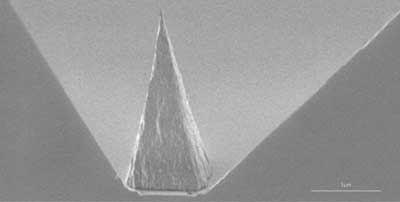| Feb 22, 2019 | |
A tip for future nanoscale sensing(Nanowerk News) Commercially-available diamond tips used in atomic force microscopy (AFM) could help make quantum nanoscale sensing cost-effective and practical, A*STAR researchers have found. |
|
| The idea of using ‘color centers’, optically-active atomic defects in diamond, as a probe for taking highly sensitive nanoscale measurements of quantities such as elecromagnetic field, temperature, or strain is well known. In practice, however, these experiments often required the expensive fabrication of custom-designed diamond nanostructures and it is a challenge to collect the very weak optical signal that the color centers produce. | |
| Now, a recent study (ACS Photonics, "Enhancing optical readout from diamond AFM tips for quantum nanosensing") published by Victor Leong, and colleagues from A*STAR’s Institute of Materials Research and Engineering, and the Institute of High Performance Computing, suggests that use of commercial pyramid-shaped diamond AFM tips that contain silicon vacancy centers – could help. The approach has several advantages. | |
 |
|
| An example of one of the diamond pyramid tips used in the experiments. The tip has a radius of 10 nanometers allowing sensing with nanoscale spatial resolution. (© ACS) | |
| Firstly, the team’s experiments with a confocal microscope and diamond tips arranged in different orientations show that the pyramid shape of the diamond tip acts as a highly efficient collector of the weak infrared (738 nanometer) photoluminescence generated by the color center. Due to geometric effects, a larger portion of the emitted photoluminescence was channeled to the base of pyramid, resulting in a signal up to eight times stronger than other directions. | |
| In the experiments, the base of the tip was attached to a silicon nitride cantilever, transparent to the infrared light, so that the photoluminescence was able to pass through and be collected by a spectrophotometer. | |
| “In many nanosensing applications, the signal is inherently very weak and this poses a fundamental limit to the sensitivity,” explained Leong. “The ability to collect and detect a larger signal improves many performance metrics such as minimum detectable signal, resolution and measurement time, for example.” | |
| Secondly, these diamond tips are commercially available and compatible with AFM and microscope equipment, offering a path to practical implementation. “These off-the-shelf diamond AFM tips are easily available and inexpensive. They cost around SGD 100 each,” commented Leong. “If they contain color centers with suitable optical properties, they could be a low-cost substitute for other diamond nanoprobes. The lower cost and easy availability could help promote the rapid development and uptake of quantum technological applications.” | |
| The extremely small size of the diamond tips, which have a tip radius of approximately 10 nanometers and length of around 15 micrometers, means that they can be brought extremely close to the sample to be studied, maximizing measurement sensitivity and spatial resolution. | |
| “These diamond tips could potentially be used in sensing applications that are challenging to perform with other diamond structures, for example, mapping the electromagnetic properties of deep trenches or the space around closely-placed nanostructures,” commented Leong. | |
| To date, the team has focused on investigating diamond tips featuring silicon vacancy color centers but Leong says that it is possible to also introduce nitrogen vacancy color centers which are popular in magnetometry studies. | |
| “The batch of diamond tips discussed in the paper were manufactured in a nominally nitrogen-free process and thus had many silicon vacancy centers but very few nitrogen vacancy centers,” explained Leong. “However, other separate batches of diamond tips we obtained, contained high concentrations of nitrogen vacancy centers.” | |
| Now that the team has shown that enhanced optical readout is possible from the diamond tips, the next stage of the research will be to optimize performance and then perform some actual sensing experiments “We plan to deploy these tips in practical nanosensing applications. Current ideas include nanoscale magnetic sensing and surface studies,” said Leong. |
| Source: A*STAR | |
|
Subscribe to a free copy of one of our daily Nanowerk Newsletter Email Digests with a compilation of all of the day's news. |
